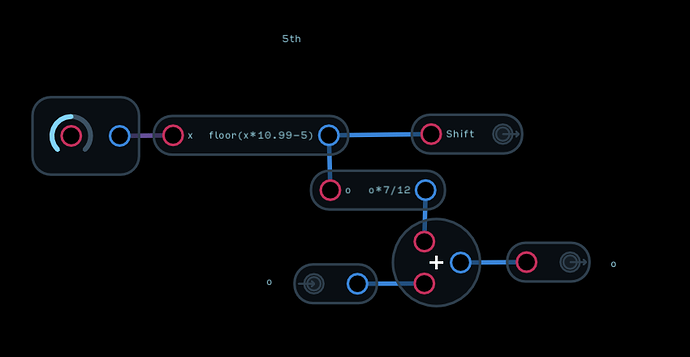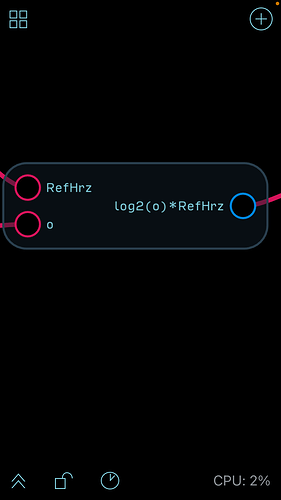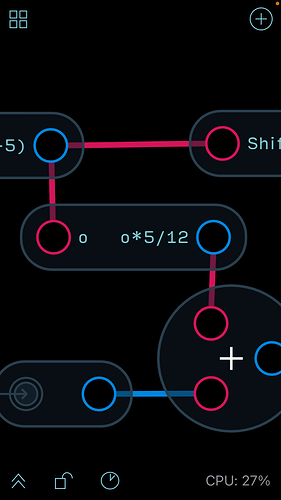So, I figured that if a basic VCO can jump to different octaves, it should be possible to do this also with, let’s say, fifths, right? That would be awesome. I figured out where this might be configured and it must have to do with the expression inside the ‘octave’ patch and the Hrzpatch inside that. Am I on a right track? Would really like to find out the expr. that changes oct to fifth!
Got on my way! Only now I get some triad and chromatic scale in the higher region:))
If you’re using a module that accepts the 1 per octave standard rather than raw Hz, it’s pretty straightforward. Using 1 per octave, to raise the pitch by an octave just add one. Each semitone is 1/12 of an octave so a fifth is 7 semitones or 7/12, so to raise a tone by a fifth just add 7/12 and to lower it subtract 5/12.
I like to use a formula to offset hz by steps or cents:
2^(steps/12)*hz or 2^(cents/1200)*hz
(I also like using cents for pitch modulation – for example, (bipolar) LFO * cents).
Edit: for me using cents is a habit – 1v/oct scaling just clicked for me, the math is really straightforward – for ex., bipolar LFO * o modulates pitch +/-1 octaves. I’ve been feeling a little outside the agreed upon Audulus norm, now I’m in. 
Thanks! I’ll get into that!
That really helped!
I think that’s the built in conversion for o to hz? @stschoen’s suggestion to convert o into its fifth I think is simply o + 7/12. The expression I posted as option 2 would come after your conversion from o to hz.
Trying that!
Correction: the Audulus conversion from o to hz is exp2(o)*RefHz. Log2 is used in hz to o.
Exp2 and log2 are power of 2 maths. The formula I posted is the same as exp2(cents/1200)*hz, so o to hz and cents offset for hz are related this way.
By the way, we’ve been talking about equal temperament, 7/12 of an octave divided into 12 equal steps. A perfect fifth is 3/2 * hz.
Thanks. Got some real interesting stuff. But not consecutive straight fifths instead of octaves yet. But I’m on it!
I did it! Got it just right. Thanks guys!
Also , I am more than happy to help anyone. Beeing a professional musician(pianist) any qustions about harmony or general theory…, ask away!
Ok – curious, what were doing with all those fifths? 
Sorry man ! I totally oversaw your messages. I got it sorted out by schoen via private ms. My bad. Your formulas really did some great stuff for me too. Let me just try to send you the patch.

@jersmi here’s the modded oscillator: Fifth V2.audulus (22.3 KB)
It did raise an interesting question. If you shift a pitch up by 7 semitones you’re creating a fifth relative to the original pitch but if you shift down by seven semitones are you shifting down a fifth or a fourth? C shifted up 7 is G which is clearly a fifth but C shifted down 7 is F. The C is a fifth relative to F but the F is a fourth relative to C. Hmmm.
Hi! It is as follows: picture a keyboard. Fifths up from ex C=G,D,A,E,B,F#etc. Down=C:F,Bflst,Eflat,Aflat etc. C to G is a fifth. Its inversion(down) is always a fourth. Same with 2nds, thirds,fourths,fifths,sixths and sevenths. So the inversion of a third is a sixth an reverse. Did that help?
Another thing occured. I entered the expression 2*(o)*RefHz in the Hz patch and before that 5/12 in the octave shift patch. It gives the following: a root(300hz) a fifth, a fourth and finally a major third on top! What is that? Well, sounds great. I think this is really interesting. Turning the ‘fifths’ knob below a certain point it gets inaudible. (Probably have to set max/min value). But, is this not a great thing people would like to explore? Set an lfo to it and you’ll have an arpegiated major triad. Let me hear about it!


